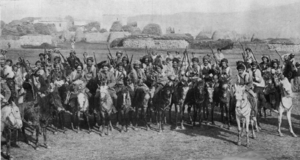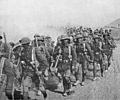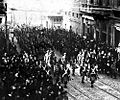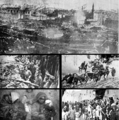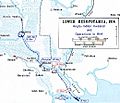Middle Eastern theatre of World War I facts for kids
The Middle Eastern theatre of World War I was a very large area where battles took place during the first World War. Here, the Allied Powers (mainly Britain and Russia) fought against the Central Powers (especially the Ottoman Empire).
This part of the war was the biggest of all the areas where WWI was fought. It included four main campaigns. In the Sinai and Palestine Campaign, British forces mostly defeated the Turkish army. In the Mesopotamian Campaign, British forces, mainly from the Army of India, also beat the Turkish army. In the Caucasus Campaign, Turkey fought against the Russian Empire and other groups. In the Dardanelles Campaign, the Turkish army defeated British forces, who were mostly from their colonies. There were also smaller fights in Arabia, Aden, and Persia.
Fighting in this region started on October 29, 1914, and ended on October 30, 1918. A peace treaty was signed on August 10, 1920.
Contents
Why the War Started Here
The Ottoman Empire joined the Central Powers in late 1914. This happened after they secretly signed an agreement with Germany on August 2, 1914. By joining, they threatened Russia's land in the Caucasus region. They also put Britain's travel routes to India and the East, especially through the Suez Canal, at risk.
The Ottoman Empire officially entered the war on October 29, 1914. This was when two German warships, the Goeben and the Breslau, which were sailing under the Turkish flag, attacked the Russian port of Odessa in the Black Sea.
Key Events of the War
1914 Battles
Mesopotamian Campaign: This fighting mostly happened in the Tigris River valley, which is now part of Iraq. Battles took place on the Persian Gulf coast, at Basra, and around the cities of Kut and Baghdad.
Caucasus Campaign: The Russian and Ottoman armies fought in the Caucasus mountains and eastern Anatolia (northeastern Turkey). The Ottoman Empire suffered a huge loss at the Battle of Sarikamis in November and December.
1915 Fights
Mesopotamian Campaign: At first, the Ottomans successfully pushed back the British attacks. However, things changed after the terrible Siege of Kut, where British forces were surrounded.
Caucasus Campaign: The Russians attacked, reaching as far as Lake Van. But the Ottoman forces eventually managed to push them back. The Ottomans' harsh treatment of the Armenian people in Anatolia, who seemed to support Russia, grew into what is now known as the Armenian Genocide. The fighting here didn't have a clear winner. Both the Ottomans and Russians then focused their efforts on the Dardanelles Campaign and the Eastern Front in Europe.
Dardanelles Campaign: This campaign started on April 25 on the Gallipoli Peninsula in Turkey. It's often called "Gallipoli" in Australia, New Zealand, and Newfoundland. British and French forces worked together to try and capture the Ottoman capital, Constantinople (now Istanbul). The campaign began with a naval attempt to force their way through the Dardanelles strait. When this failed, the Allies decided to attack the land with troops landing from the sea. The troops landed but could not remove the Ottoman forces. After months of fighting, about 131,000 soldiers died, and 262,000 were wounded. Eventually, the Allied forces left. This campaign was very important for Australia and New Zealand. They celebrate April 25th as ANZAC Day. Kemal Ataturk, who later became the first leader of modern Turkey, became famous as a Lieut. Colonel in the Ottoman army during this battle.
Arab Revolt: The British, based in Egypt, started to encourage the Arabs living in Hejaz near the Red Sea to rebel. They wanted the Arabs to drive the Ottoman forces out of what is now the Saudi Arabian peninsula.
Sinai and Palestine Campaign: The Ottomans launched an attack across the Sinai Peninsula. Their goal was to destroy or capture the Suez Canal, which was a vital waterway.
1916 Events
Arab Revolt: In 1916, a mix of talking and a real dislike for the new Ottoman leaders (called the Three Pashas) convinced Sherif Hussein ibn Ali of Mecca to start a revolt. He gave the leadership to his two sons, Faisal and Abdullah. However, much of the planning was done by Lawrence of Arabia.
Caucasus Campaign: The Russian attack in northeastern Turkey led to them capturing Erzerum in February and Trabzon in April.
Sinai and Palestine Campaign: The Ottoman forces launched a second attack across the Sinai Peninsula to try and capture the Suez Canal. Both this attack and the earlier one (in 1915) failed. They were not very costly battles compared to other parts of the Great War. The British then began to attack, moving east into Palestine. However, two failed attempts to capture the Ottoman fort of Gaza led to big changes in the British command. General Allenby arrived with many new soldiers.
1917 Developments
Mesopotamian Campaign: British Empire forces reorganized and captured Baghdad in March 1917.
Caucasus Campaign: Russia effectively left the war in 1917. The Treaty of Brest-Litovsk in 1918 eventually gave back to the Ottoman Empire the lands it had lost to Russia during the war.
Arab Revolt: The revolt was successful. General Allenby's capture of Palestine in 1917 helped a lot (see the Sinai and Palestine Campaign for more).
Sinai and Palestine Campaign: Late in 1917, General Allenby's Egyptian Expeditionary Force broke through the Ottoman defenses. They captured Gaza and then took Jerusalem just before Christmas. While this event wasn't super important for the overall war, it was key to the later creation of Israel as a separate nation in 1948.
1918 Final Battles
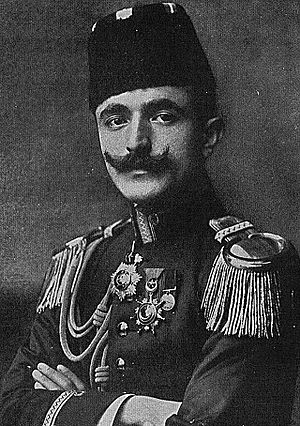
Sinai and Palestine Campaign: The Ottoman Empire could be defeated by campaigns in Palestine and Mesopotamia. The Spring Offensive in Europe delayed the expected attack. General Allenby received brand new divisions of soldiers from India. The British gained full control of the air. General Liman von Sanders, the Ottoman commander, had no clear idea where the British would attack. To make things worse, the Ottomans moved their best troops to the Caucasus Campaign. General Allenby finally launched the Battle of Megiddo. Ottoman troops then began a full retreat.
Arab Revolt: T. E. Lawrence and his Arab fighters carried out many quick attacks on supply lines. This kept thousands of Ottoman soldiers busy in garrisons across Palestine, Jordan, and Syria.
Caucasus Campaign: The Grand vizier Talat Pasha signed the Treaty of Brest-Litovsk on March 3, 1918, with Russian SFSR. This treaty stated that Russia would give Batum, Kars, and Ardahan to the Ottoman Empire. The Treaty of Brest-Litovsk brought together the Armenian-Georgian areas. The Democratic Republic of Armenia declared war on the Ottoman Empire. In early May 1918, the Ottoman army faced the Armenian Corps. This group soon declared the Democratic Republic of Armenia. The Ottoman army captured Trabzon, Erzurum, Kars, Van, and Batumi. The fighting led to the Battle of Sardarapat, the Battle of Kara Killisse (1918), and the Battle of Bash Abaran. Even though the Armenians defeated the Ottomans at the Battle of Sardarapat, the Ottoman army won later battles and scattered the Armenian army. The fight with the Democratic Republic of Armenia ended with the signing of the Treaty of Batum in June 1918. However, throughout the summer of 1918, under the leadership of Andranik Toros Ozanian, Armenians in the mountainous Karabag region resisted the Ottoman 3rd army. They established the Republic of Mountainous Armenia. The Army of Islam avoided Georgia and marched to the Azerbaijan Democratic Republic. They reached Baku on the Caspian Sea. They drove the British out in September 1918 with the Battle of Baku.
The End of Fighting: October 30, 1918
The Armistice of Mudros was signed on board HMS Agamemnon in Mudros port on the island of Lemnos. This happened on October 30, 1918, and it brought an end to the Sinai and Palestine Campaign.
Peace Treaty: August 10, 1920
The Ottoman Government signed the Treaty of Sèvres on August 10, 1920. However, the Turkish national movement did not accept this treaty, so it never actually took effect.
Images for kids
-
A timeline of events on the Eastern and Middle-Eastern parts of World War I.
-
Austrian troops marching up Mount Zion in Jerusalem, 1916.
-
The Turkish general staff of the Mesopotamian campaign, 1916.
-
Ottoman trenches along the shores of the Dead Sea, 1918.
-
The Allied forces occupying Constantinople.
-
The Turkish general staff of the Sinai and Palestine Campaign, 1914.
-
Ottoman forces preparing for the attack on the Suez Canal, 1914.
-
People from the Armenian volunteers including Khetcho, Dro, and Armen Garo, 1914.
-
Zoravar Andranik's 1st battalion of Armenians spread out in the Salmast and Urmia districts in the early parts of the Persian Campaign, December 1914.
-
The first British attack during the Mesopotamian campaign, 1914.
-
6th Army field HQ during the Mesopotamian campaign, 1915.
-
The camel corps at Beersheba during the Sinai and Palestine Campaign, February 1915.
-
The Bouvet during the Gallipoli Campaign, March 1915.
-
Mustafa Kemal at Gallipoli with his soldiers, 1915.
-
The trenches during the Siege of Kut, December 1915.
See also
 In Spanish: Frente del Oriente Próximo (Primera Guerra Mundial) para niños
In Spanish: Frente del Oriente Próximo (Primera Guerra Mundial) para niños


